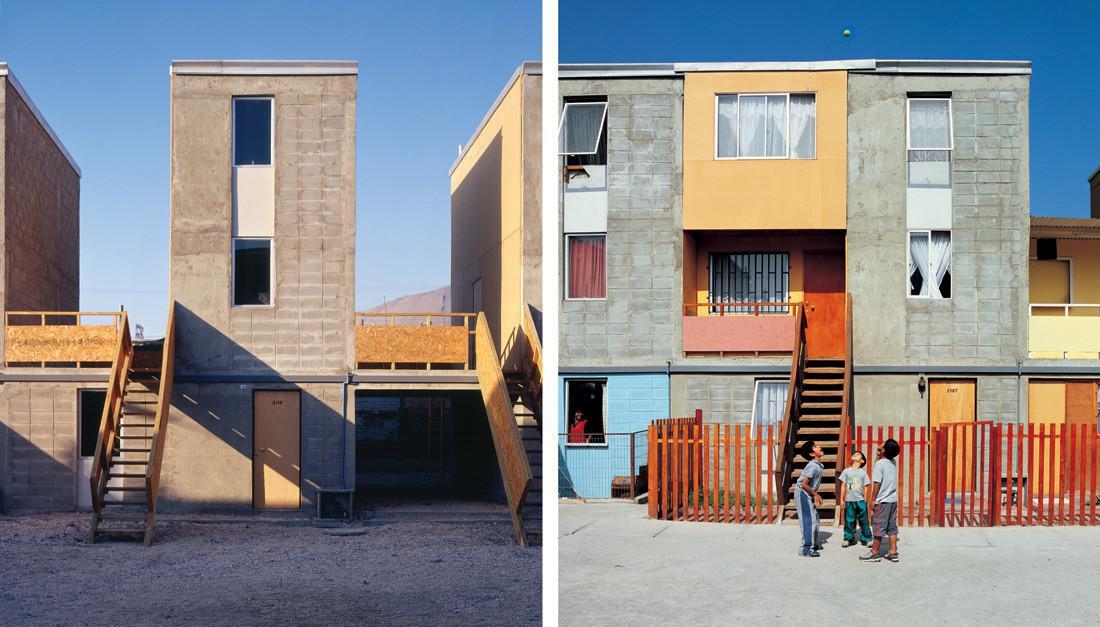
6 minute read
Mas Con Lo Mismo Alejandro Aravena’s Architecture Of Scarcity
https://www.archdaily.com/10775/quinta-monroy-elemental

Advertisement





By Dimitra Houvarta
The concern for a sustainable future lead to a complicated and difficult road. Design however can be a powerful tool towards that road. Design does not just consist of the manipulation of materials, but also of how the built environment, the products and the services are used and mainly how people will manage to live together meaningfully. Design should not be reduced to a mere technical solution but should be the comprehensive approach to improve people’s quality of life. Is there today any example of architecture practice that is built upon these concerns?

A certain amount of people in many contemporary cities lives below the poverty line, while many live-in unhealthy conditions or even worst are homeless. The need for affordable and quality social housing now is urgent and will be even more in the future. Innovative design of the future cities will be crucial for a sustainable housing of the increasing population in cities. That was the challenge which the Chilean Architect Alejandro Aravena, had to take upon with his studio Elemental. Aravena’s starting point for architectural design is “that the right design sustainability is nothing but the rigorous use of common sense. The results are often simple solution to the complex challenges”. 1 With this Alejandro Aravena highlighted that sustainable design could simply mean to include the needs of citizens in the design and created synergies between the people, the government and other involved stakeholders in order to satisfy these needs in the simplest way possible. Having this philosophy in mind all three dimensions of sustainability are balanced in a participatory process: socially, environmentally and economical.
‘’The Role OfThe Architect Is Being Challenged To Serve
Greater Social And H umanitarian Needs” 2
Aravena highlights the ethical purpose of architecture when he argues that “Architecture serves progress” 3 however he also argues that this progress should be in benefit of the local communities. This is something he pursues in the different projects of his practice located mainly in Chile. For Aravena architectural design should focus on the neighbourhood as the expression of the community in the city space. As he argues: “designing and building better neighbourhood is crucial if we want development to break the vicious circle of inequality” 4 . This priority informs the principles that Elemental Studio sets in the beginning of a project. Elemental team thinks, designs and builds better neighbourhoods, housing and the necessary urban infrastructure to promote social development and overcome the circle of poverty and inequality of the cities. By providing quality Aravena argues that “we understand projects whose design guarantees incremental value and returns on investment overtime, in order to stop considering it a more social expense”. 5 In this spirit, Elemental contributes to improve the quality of Chilean cities, providing state of the art architecture and engineering, understanding the city as an unlimited resource to build social equity.
For Aravena an important factor of each project is the available budget and the price of land. He argues that architects should find solutions among problems such as a low budget for ordinary public housing, and a high price for land. This is possible, he argues, with inventive and creative thinking. This creative thinking was conceived and tested by Elemental studio in 2004, when the team asked to accommodate 100 families, that was had been living illegally to a shantytown in the city centre of Iquique in Chile. The only fund they had was $10.000 subsidy with which they had to buy the land, to provide infrastructure and build the houses. Moreover, because the land was in the city centre it was three times more expensive and according to that the only solution, they had was to extend the houses in height in the limited land which they had available. The idea developed by Elemental team was an open housing typology using semi-built houses that are going to finished by the inhabitants themselves. be As Aravena stated, “Building half a good house instead of a small one” 6 this is direct result of his famous ‘mas con lo mismo’ motto –‘doing more with the same’. In this case by using the same budget the ‘Do Tank’ team managed to offer what family could not do correctly by itself: the kitchen,
built - houses/ 6/january/14/why - 2016s - pritzker - winner - makes - half https://de.phaidon.com/agenda/architecture/articles/201 the bathroom, the partitioning walls and the insulation. This strategic solution has an ecological content and it proves that Architecture can become sustainable by itself when using the project as an open process of transformation. Upon completing this project Elemental used the same mentality of ‘mas con lo mismo’ with the use of materials. He focused on cheap but durable materials such as concrete and brick that were provided locally in order to provide the ‘half house’ to the residents who, in their turn had to develop the other half with materials that could find by themselves and are easy to use. The residents responded positively and one year after they filled in the empty spaces with diverse and imaginary solutions that responded to the needs of each family. This kind of comprehensive design is a persuading expression regarding the impact of social change and of the capability of reversibility of the structure imagined by Elemental. The framework which is solid and distinct was accompanied by a process that developed a neighbourhood and stimulated development, and this framework will continue to grow.


https://www.pinterest.es/pin/521995413060032014/?lp=true
Concluding, one can observe that with the model that Aravena proposes social housing becomes an investment rather than a social expense. The inhabitants of Quinta Monroy benefited from this investment and as the years passed, they had the ability to build additions, to customise the design of the house, to increase the value of it or the ability build quickly, without reducing the quality. With this process that Aravena proposes sustainable thinking is enriched and can be understood as an inclusive process that combines the sustainable development of a local community, the sustainable use of structures and materials without however overlooking the economic development of the city and the need to have a big impact in space with a low budget. Overall, this highlights that better design outcomes are possible when an incremental approach is planned from the outset of development, and as Professor Pablo Allard stated:
“His holistic and participatory approach in nowbeing followedby othercities”. 7
1.
2.
3.
4. 5.
6.
7. https://www.archdaily.com/869994/alejandro-aravena-wins-2017- gothenburg-prize-for-sustainable-development https://www.theguardian.com/artanddesign/2016/apr/10/architectalejandro-aravena-pritzker-prize-elemental-housing-iquiqueconstitucion-tsunami-defences https://www.theguardian.com/artanddesign/2016/apr/10/architectalejandro-aravena-pritzker-prize-elemental-housing-iquiqueconstitucion-tsunami-defences Reader Book ( page. 114, paragraph.2) https://www.ted.com/talks/alejandro_aravena_my_architectural_philos ophy_bring_the_community_into_the_process/transcript https://www.buildinggreen.com/newsbrief/sustainable-developmentthrough-open-source-participatory-design https://www.theguardian.com/artanddesign/2016/apr/10/architectalejandro-aravena-pritzker-prize-elemental-housing-iquiqueconstitucion-tsunami-defences










